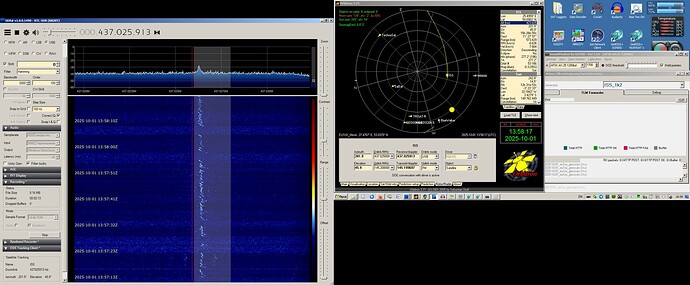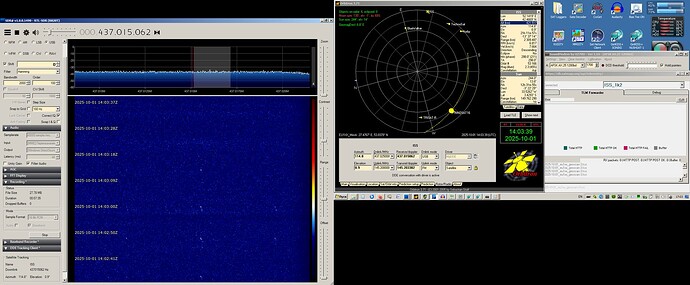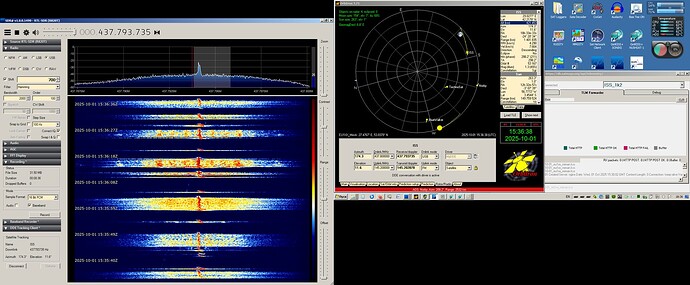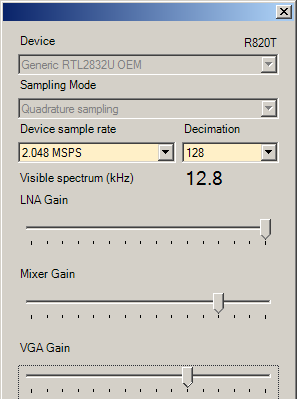fredy
September 23, 2025, 5:13pm
21
I’ve created a separate topic topic for this as you suggested to discuss it a little more.
The only known transmission around that frequency was from the Russian satellites deployed by hand Tanusha 1 and 2 and Tomsk-TPU-120.
I’m wondering what is the source of this signal.
2 Likes
EU1SAT
September 23, 2025, 5:19pm
22
A weak signal, it seems to be broken or not connected antenna.
1 Like
fredy
September 23, 2025, 5:24pm
23
I’ll create a new transmitter for ISS and try to watch if we can get more observations.
As still close, I’ll share the time of the stations between the ISS and the deployed satellites.
2 Likes
K4KDR
September 23, 2025, 6:12pm
24
While it seems unlikely, I believe that there are some not-yet-deployed cubesats on the ISS from NG-23 that are scheduled to downlink in the lower 437 MHz range:
EagleSat-2: 437.165
SilverSat: 437.175
1 Like
fredy
September 24, 2025, 9:47am
25
I think the first step should be to verify that this transmission is 100% coming from ISS, so we need observations from other stations to verify it.
@EU1SAT don’t get me wrong I believe you and I’m 99% sure is coming from ISS, but I have this 1% that we may miss something.
In parallel there was also a similar finding near this frequency we are talking about:
Here is an interesting reception SatNOGS Network - Observation 12410418 .
The signal seems to fit the ISS TLE but not the new ones we generated for GHS-01. The signal is at 437.081, instead of the 437.090 and it is very faint and not visible in other high pass observations at the same time. Also the signal looks like voice.
I’m not sure how to interpret this and in my mind run different scenarios:
The signal comes from ISS, then why is so faint and why in this unexpected frequency.
The signal…
Not exactly at 437.025 but near.
K4KDR:
While it seems unlikely, I believe that there are some not-yet-deployed cubesats on the ISS from NG-23 that are scheduled to downlink in the lower 437 MHz range:
EagleSat-2: 437.165
SilverSat: 437.175
To be honest I’m finding it unlikely given that the observed frequency is more than 100KHz away from these satellites’ frequencies. But it doesn’t hurt to keep it as a scenario.
1 Like
fredy
September 25, 2025, 12:49pm
26
@EU1SAT Did you noticed any other transmission than the ones you shared?
From the Network’s observations there isn’t anything observed until now. But I’ve scheduled a couple more observations for the next days to see.
EU1SAT
September 25, 2025, 7:37pm
27
Within 3 days, I observed this signal on several pass every day.
The signal is very weak and a high performance antenna is required.
2 Likes
EU1SAT
October 1, 2025, 2:10pm
28
3 Likes
EU1SAT
October 1, 2025, 3:49pm
29
It seems that my observations are a signal transfer from 437.800 MHz due to ADC overload!!!
I think the topic can be closed or even deleted.
To @fredy :
5 Likes
SA2KNG
October 1, 2025, 7:59pm
30
No worries (:
I’m guessing youre running the rtlsdr at 1.536MHz ? I think that could explain the 768kHz difference giving 437.032MHz
2 Likes
EU1SAT
October 1, 2025, 8:02pm
31
Today:
In previous observations, I used Decimation 64 and 32.
1 Like
fredy
October 2, 2025, 7:51am
32
Thank you for letting us know! Another mystery solved!
No need to apologize, RF observations can be tricky, so everything is a lesson for our community!
I’m going to invalidate the transmitter in the next hour.
2 Likes



